31 Jul , 2025 By : Debdeep Gupta

The Nifty 50 extended its upward journey with moderate gains of 34 points amid rangebound trading on July 30, especially ahead of the monthly F&O contracts expiry due on July 31 and the FOMC meet outcome tonight where the interest rates were left unchanged. The index remained within the 50-day EMA (24,950) and 100-day EMA (around 24,600), which can act as key resistance and support levels in the upcoming sessions. If the index fails to defend the 24,650–24,600 support zone, amid a possible knee-jerk reaction to Trump's 25 percent tariff imposition on India, the bears may gain strength. However, on the higher side, surpassing 24,950 could open the door for 25,150–25,250 levels, according to experts.
Here are 15 data points we have collated to help you spot profitable trades:
1) Key Levels For The Nifty 50 (24,855)
Resistance based on pivot points: 24,893, 24,924, and 24,974
Support based on pivot points: 24,793, 24,763, and 24,713
Special Formation: The Nifty 50 formed a small bearish candle with a lower shadow on the daily charts after the previous day's Bullish Engulfing candle, while also negating the lower highs–lower lows formation of the previous three sessions. This indicates rangebound action below the immediate hurdle of 24,900–25,000, as per the change in polarity. The index remained below the 50-day and 20-day EMAs, while the Stochastic RSI showed a bullish crossover, and MACD histogram weakness waned further. The RSI inched up further to 43.25. Altogether, these indicators suggest cautious optimism within a constrained range.
2) Key Levels For The Bank Nifty (56,151)
Resistance based on pivot points: 56,277, 56,337, and 56,435
Support based on pivot points: 56,081, 56,020, and 55,922
Resistance based on Fibonacci retracement: 56,650, 57,058
Support based on Fibonacci retracement: 56,091, 55,675
Special Formation: The Bank Nifty continued to defend the 50-day EMA on a closing basis as well as the falling support trendline, although it formed a bearish candle on the daily timeframe and fell 71 points with above-average volumes. The banking index also negated the lower highs–lower lows pattern of the previous three straight sessions but still traded below the 20-day EMA. The RSI stood at 44.14, while both the Stochastic RSI and MACD maintained bearish crossovers, with the MACD histogram weakening further. These indicators collectively point to a continued bearish undertone, despite near-term support holding.
3) Nifty Call Options Data
According to the monthly options data, the maximum Call open interest was seen at the 25,000 strike (with 1.57 crore contracts). This level can act as a key resistance for the Nifty in the short term. It was followed by the 25,500 strike (1.32 crore contracts), and the 24,900 strike (1.21 crore contracts).
Maximum Call writing was observed at the 24,900 strike, which saw an addition of 41.31 lakh contracts, followed by the 24,950 and 25,500 strikes, which added 18.57 lakh and 17.86 lakh contracts, respectively. The maximum Call unwinding was seen at the 24,800 strike, which shed 26.91 lakh contracts, followed by the 24,700 and 24,750 strikes, which shed 9.53 lakh and 8.95 lakh contracts, respectively.
4) Nifty Put Options Data
On the Put side, the 24,800 strike holds the maximum Put open interest (with 1.12 crore contracts), which can act as a key support level for the Nifty. It was followed by the 24,700 strike (86.47 lakh contracts) and the 24,500 strike (84.41 lakh contracts).
The maximum Put writing was placed at the 24,850 strike, which saw an addition of 46.41 lakh contracts, followed by the 24,900 and 24,800 strikes, which added 37.22 lakh and 23.79 lakh contracts, respectively. The maximum Put unwinding was seen at the 24,300 strike, which shed 7.02 lakh contracts, followed by the 25,200 and 25,100 strikes, which shed 4.74 lakh and 3.5 lakh contracts, respectively.
5) Bank Nifty Call Options Data
According to the monthly options data, the 57,000 strike holds the maximum Call open interest, with 25.27 lakh contracts. This can act as a key resistance level for the index in the short term. It was followed by the 57,500 strike (17.17 lakh contracts) and the 58,000 strike (15.64 lakh contracts).
Maximum Call writing was visible at the 56,200 strike (with the addition of 5.6 lakh contracts), followed by the 56,500 strike (2.9 lakh contracts), and the 56,300 strike (2.87 lakh contracts). The maximum Call unwinding was seen at the 57,500 strike, which shed 1.53 lakh contracts, followed by the 57,100 and 57,900 strikes, which shed 94,570 and 92,120 contracts, respectively.
6) Bank Nifty Put Options Data
On the Put side, the maximum Put open interest was seen at the 56,000 strike (with 15.8 lakh contracts), which can act as a key support level for the index. This was followed by the 55,000 strike (10.77 lakh contracts) and the 56,200 strike (8.41 lakh contracts).
The maximum Put writing was observed at the 56,200 strike (which added 3.63 lakh contracts), followed by the 56,000 strike (2.7 lakh contracts) and the 56,100 strike (2.36 lakh contracts). The maximum Put unwinding was seen at the 57,100 strike, which shed 82,950 contracts, followed by the 57,000 and 55,000 strikes, which shed 63,945 and 67,375 contracts, respectively.
7) Funds Flow (Rs crore)
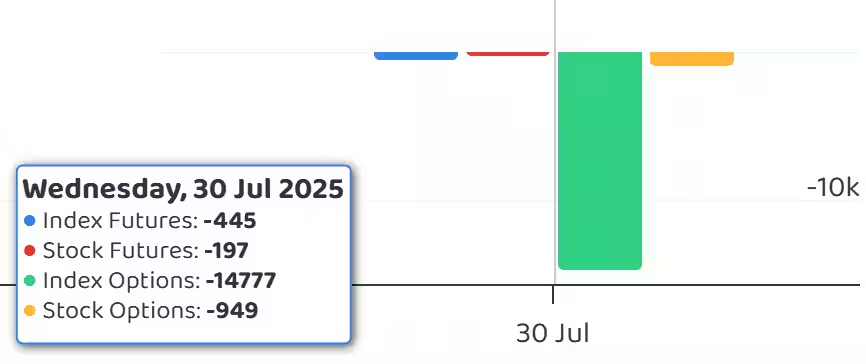
8) Put-Call Ratio
The Nifty Put-Call ratio (PCR), which indicates the mood of the market, climbed further to 0.87 on July 30, compared to 0.8 in the previous session.
The increasing PCR, or being higher than 0.7 or surpassing 1, means traders are selling more Put options than Call options, which generally indicates the firming up of a bullish sentiment in the market. If the ratio falls below 0.7 or moves towards 0.5, then it indicates selling in Calls is higher than selling in Puts, reflecting a bearish mood in the market.
9) India VIX
The India VIX, known as the fear index, fell further to 11.20, down 2.78 percent, extending its downtrend for another session. This provided some comfort and stability to the market and signaled a less fearful or uncertain environment for investors.
10) Long Build-up (41 Stocks)
A long build-up was seen in 41 stocks. An increase in open interest (OI) and price indicates a build-up of long positions.
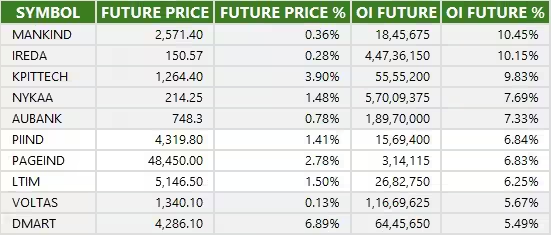
11) Long Unwinding (63 Stocks)
63 stocks saw a decline in open interest (OI) along with a fall in price, indicating long unwinding.
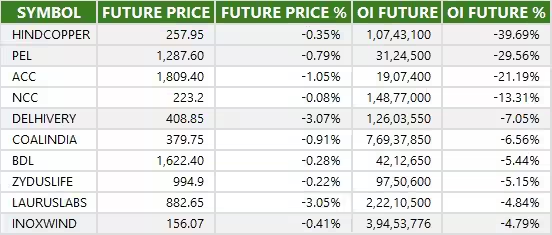
12) Short Build-up (72 Stocks)
72 stocks saw an increase in OI along with a fall in price, indicating a build-up of short positions.
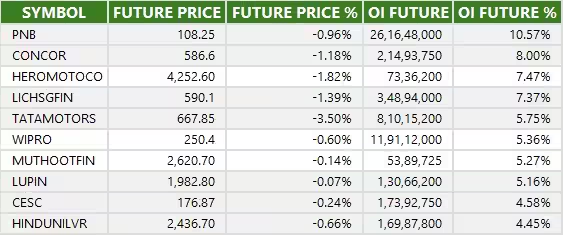
13) Short-Covering (52 Stocks)
52 stocks saw short-covering, meaning a decrease in OI, along with a price increase.
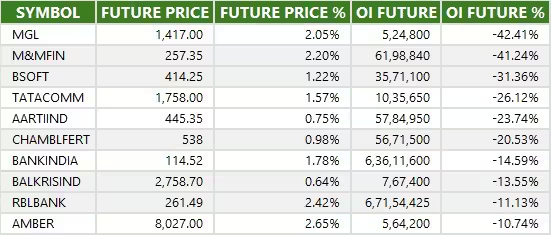
14) High Delivery Trades
Here are the stocks that saw a high share of delivery trades. A high share of delivery reflects investing (as opposed to trading) interest in a stock.

15) Stocks Under F&O Ban
Securities banned under the F&O segment include companies where derivative contracts cross 95 percent of the market-wide position limit.
Stocks added to F&O ban: Nil
Stocks retained in F&O ban: Nil
Stocks removed from F&O ban: RBL Bank
0 Comment